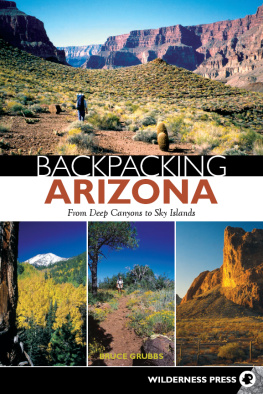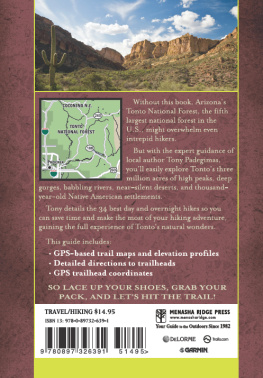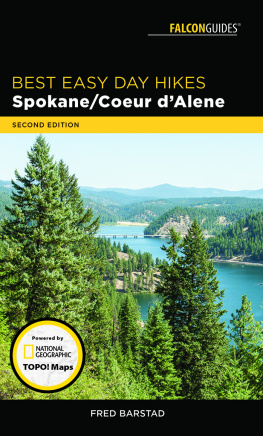
LOOP HIKES
Arizona


LOOP HIKES
Arizona
Bruce Grubbs

 | THE MOUNTAINEERS BOOKS
is the nonprofit publishing arm of The Mountaineers Club, an organization founded in 1906 and dedicated to the exploration, preservation, and enjoyment of outdoor and wilderness areas. |
1001 SW Klickitat Way, Suite 201, Seattle, WA 98134
2004 by Bruce Grubbs
All rights reserved
First edition, 2004
No part of this book may be reproduced in any form, or by any electronic, mechanical, or other means, without permission in writing from the publisher.
Published simultaneously in Great Britain by Cordee, 3a DeMontfort Street, Leicester, England, LE1 7HD
Manufactured in Canada
Acquiring Editor: Cassandra Conyers
Project Editor: Mary Metz
Copy Editor: Paula Thurman
Cover and Book Design: The Mountaineers Books
Layout: Mayumi Thompson
Cartographers: Moore Creative Designs and Steve Cherkas
All photographs by Bruce Grubbs unless otherwise indicated.
Cover photograph: Saguaro cactus are the symbol of the Sonoran Desert.
Frontispiece: Pinnacle Balanced Rock, Heart of Rocks Trail
Maps shown in this book were produced using National Geographics TOPO! software. For more information, go to www.nationalgeographic.com/topo.

Library of Congress Cataloging-in-Publication Data
Grubbs, Bruce (Bruce O.)
Best loop hikes, Arizona / by Bruce Grubbs. 1st ed.
p. cm.
Includes index.
1. HikingArizonaGuidebooks. 2. ArizonaGuidebooks. I. Title.
GV199.42.A95G78 2004
917.910454dc22
2004020871
 Printed on recycled paper
Printed on recycled paper
CONTENTS

MAP LEGEND
 | Interstate highway |
 | Paved road |
 | Unpaved road |
 | Featured trail |
 | Connecting trail |
 | Cross-country trail |
 | River/creek |
 | Lake |
 | Spring |
 | Interstate |
 | U.S. highway |
 | State or County road |
 | Forest road |
 | Trailhead |
 | Parking |
 | Campground or Site |
 | Pass/saddle |
 | Peak |
 | Visitors Center |
ACKNOWLEDGMENTS
Id like to thank the following people who reviewed the manuscript and made valuable suggestions: Steve Bridgehouse, Grand Canyon National Park; Sharlot Minor, Kaibab National Forest; Suzanne Moody, Chiricahua National Monument; and Betsy D. Warner, The Nature Conservancy. Thanks also to my many hiking companions over the years, who have not only made the backcountry more enjoyable but who have also patiently endured my photographic and trail mapping efforts. Special thanks to Duart Martin, who as always encouraged this book every step of the way.
PREFACE
Wilderness is our lifeline to the past. Without it, we have no record of how humans have changed the face of the earth. Our wild lands are sentries of a bygone era when Nature thrived in its most intact, undamaged statethe epitome of balance. Save for small patches here and there, gone are the vast swaths of tall grass prairie that bore great herds of bison; gone are the rambling, undeveloped coastlines of the Eastern and Western United States; gone are the giant hardwood forests of Appalachia, great tracts of Adirondack spruce, and millions of acres of old-growth ponderosa pine in the Southwest. Vanished, too, are many of the cultures that lived in harmony with our wild lands. What we have left are fragments of our nations identity thatwithout adequate protection from mining, off-road vehicle use, logging, invasive species, climate change, and developmentwill also disappear without so much as a whisper.
In Arizona, the threat of losing our wilderness is greater than ever. Arizona has risen on U.S. census charts to the second-fastest growing state in the nation. Ironically, one of the most enticing lures for those moving to Arizona is access to the outdoors. Here one can find snow-capped mountains and deep rugged canyons; blooming desert and spring-fed streams; verdant conifer forests and fiery orange sunsets. This wild natural symphony is open to hikers, campers, boaters, horseback riders, hunters, photographers, fishermen, and other nature lovers to enjoy. Yet Arizona guards only 6 percent of its public lands under the protective mantle of wilderness.
The Arizona Wilderness Coalition (AWC) is a statewide alliance of concerned groups and individuals working to protect and restore Arizonas wild lands and waters. The Coalition conducts wilderness inventories and educates citizens and Congress about the unique features of Arizonas landscape. Gaining the support of local communities, businesses, civic groups, and government agencies, we advocate for the congressional legislation necessary to ensure lasting wilderness protection. The Coalition has identified an additional 6 million acres of public lands in Arizona that are suitable for wilderness designation, including spectacular wild lands in lush, high-elevation forests, in the secluded Sonoran and Western deserts, and within the treasured Grand Canyon.













 Printed on recycled paper
Printed on recycled paper


















